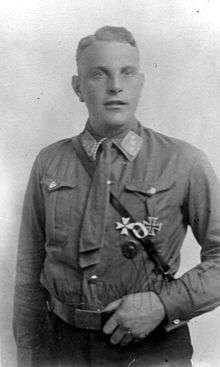Edmund Heines

Edmund Heines (21 July 1897, Munich – 30 June 1934, Stadelheim Prison) was a Nazi Party leader and Ernst Röhm's deputy in the Sturmabteilung or SA.[1]
Life
Heines served in World War I as a Kriegsfreiwilliger and was discharged in 1918 as a lieutenant. From 1919 to December, 1922, he served as leader of a unit in Freikorps Roßbach and later as Gruppenführer of the Munich Ortsgruppe. In December, 1922, he transferred to the Nazi Party and the SA (stormtroopers).
In 1929, he was convicted of the murder of communist Conrad Pietrzuch, who had been beaten to death by an SA gang led by Heines. The trial had to be reopened due to a technical error, and Heines soon received an amnesty because of his supposedly "patriotic" motive.[2] That same year, he was appointed to temporarily serve as the head of a Nazi district in the Upper Palatinate region. In 1930, Heines became a member of the Reichstag for the district of Liegnitz. From 1931 to 1934, he served as an SA leader in Silesia while simultaneously working as Ernst Röhm's deputy. In 1933, Heines was on the Prussian privy council, and in May of the same year he became head of police in Breslau.
Execution
Hitler's chauffeur Erich Kempka claimed in a 1946 interview that Edmund Heines was caught in bed with an unidentified 18-year-old male when he was arrested during the Night of the Long Knives, although Kempka did not actually witness it. According to Kempka, Heines refused to cooperate and get dressed. When the SS detectives reported this to Hitler, he went to Heines's room and ordered him to get dressed within five minutes or risk being shot. After five minutes had passed by, Heines still had not complied with the order. As a result, Hitler became so furious that he ordered some SS men to take Heines and the boy outside to be executed.[3]
Heines, Röhm, and many other SA leaders were executed shortly after their arrest. Hitler identified Heines as one of the principal members of a "small group of elements which were held together through a like disposition" in his Reichstag speech of 13 July 1934.
Heines's younger brother, Oskar (born on 3 February 1903 in Munich) was also an SA officer. On the morning of 1 July 1934, he heard a radio report concerning the execution of his brother. Soon after, SA-Obersturmbannführer Oskar Heines, along with SA-Obersturmbannführer Werner Engels, reported to the Polizeiprasidium in Breslau. They were immediately placed under arrest by SS men. From there, they were driven that night to a forested area near Deutsch-Lissa (now Wrocław-Leśnica, Poland). At dawn on 2 July 1934, the two were shot on orders of SS-Obergruppenführer Udo von Woyrsch.
Notes
- ↑ Lothar Machtan (2001). The Hidden Hitler, translated by John Brownjohn, Oxford: The Perseus Press, p. 111.
- ↑ Davidson, Eugene, The Making of Adolf Hitler: The Birth and Rise of Nazism, University of Missouri Press, 1997, p.333-4.
- ↑ "Night of the Long Knives : Nazi Germany".
References
- Miller, Michael D. and Schulz, Andreas (2012). Gauleiter: The Regional Leaders of the Nazi Party and Their Deputies, 1925-1945 (Herbert Albreacht-H. Wilhelm Huttmann)-Volume 1, R. James Bender Publishing. ISBN 978-1932970210